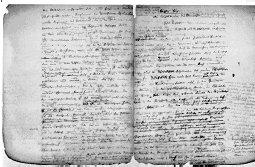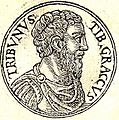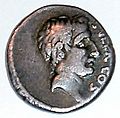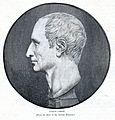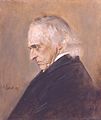The History of Rome (Mommsen) facts for kids
The History of Rome (in German, Römische Geschichte) is a famous multi-volume book series about ancient Rome. It was written by Theodor Mommsen (1817–1903), a German historian. The first three books, published between 1854 and 1856, focused on the Roman Republic. Later, another book came out about the different provinces of the Roman Empire. In 1992, a new book about the Empire was published. This book was put together from Mommsen's old lecture notes.
The first three books were very popular right away. They made Mommsen famous. Even today, people still read and use his work. The History of Rome is Mommsen's most well-known book. It was even mentioned when he won the Nobel Prize.
Contents
How the Book Started
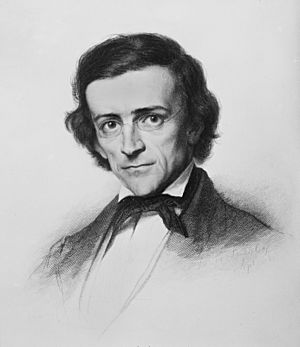
Theodor Mommsen wrote The History of Rome after already studying ancient Rome for a long time. He hadn't planned to write a history book. But in 1850, when he was a professor at the University of Leipzig, an opportunity came up.
Mommsen gave a public talk about the Gracchi brothers. Publishers named Reimer and Hirzel were there. Two days later, they asked him to write a history of Rome for their book series. Mommsen had recently lost his job at the university because of his political actions. So, he agreed to write the book. He said it was "partly for my livelihood, and partly because the work greatly appeals to me."
The publishers wanted the book to focus on events and situations. They asked Mommsen not to talk too much about the scholarly research process. They wanted a respected academic book. But they also wanted it to be easy to read and interesting for the general public. Mommsen was a skilled scholar and had also worked as a journalist. This helped him become a popular author. He wrote to a friend, "It is high time for such a work... it is more than ever necessary to present to a wider audience the results of our researches."
Publishing the Books
The First Books
Originally, The History of Rome was planned to be five books. It was meant to cover Roman history from its very beginning up to the emperor Diocletian (who ruled from 284 to 305 AD).
The first three books were published in 1854, 1855, and 1856. These books covered the early history of Rome and the fall of the Roman Republic. They ended with the changes made by Julius Caesar. These three books became very popular right away. Readers loved how a professional scholar could write with such energy and life. They found that Mommsen combined great detail with a clear vision. Especially in the third book, when he wrote about the Roman Republic's political problems, he wrote with strong emotion. It was like reading a scientific history book that felt as exciting as a novel.
These first three books stayed popular in Germany. Eight editions were published during Mommsen's lifetime. After he passed away in 1903, eight more German editions were released.
Later Books in the Series
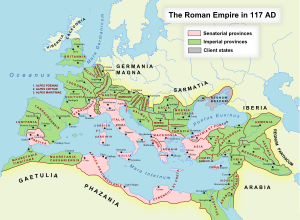
Mommsen had planned a fourth book about the Roman Empire. However, this book was delayed. Mommsen was busy working on a huge 15-volume project called Corpus Inscriptionum Latinarum. This project involved researching, writing, and editing Roman inscriptions. It took him many years. Because of these delays, the planned fourth book was never published. Some people think an early version of the manuscript might have been lost in a fire.
Even without a "fourth volume," Mommsen published another book on ancient Roman history in 1885. This book described the different imperial provinces. In Germany, it was published as the fifth book of his Römische Geschichte. In this book, Mommsen discussed each of the Roman Empire's provinces as its own topic. It didn't have a continuous story of political events like his first three books. The English version of this book was called The Provinces of the Roman Empire from Caesar to Diocletian.
In 1992, a "reconstructed" version of Mommsen's missing "fourth volume" about the Empire was published. It was based on lecture notes taken by two of Mommsen's students, Sebastian Hensel and his son Paul Hensel. They had taken notes from Mommsen's lectures on the politics of the Roman Empire at the University of Berlin between 1882 and 1886. A scholar named Alexander Demandt found these notes in 1980 in a used bookshop. Barbara Demandt and Alexander Demandt edited the notes to create the "reconstructed" German text, Römische Kaisergeschichte.
English Translations
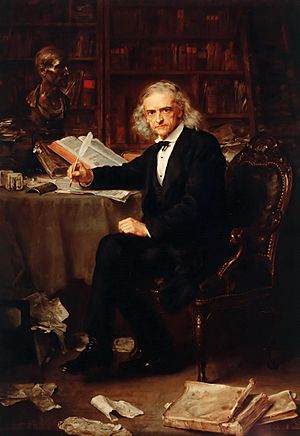
The English translations of Mommsen's work were done by William Purdie Dickson. He was a professor at the University of Glasgow. The first three German books were published in English between 1862 and 1866. Over many years, Professor Dickson prepared more English editions. He made sure to keep up with Mommsen's changes in the German versions. In total, nearly a hundred English editions and reprints have been published.
In 1958, parts of the last two "books" from the original three-volume History were chosen for a shorter English version. This shorter book highlighted Mommsen's story of the social and political struggles that led to the fall of the Roman Republic. This new version had updated notes and a revised translation. It showed Mommsen's careful way of telling the important political drama and explaining what it meant. The book ended with his long description of the new government system hinted at by Julius Caesar.
Professor Dickson also quickly oversaw the translation of Mommsen's 1885 "fifth volume" about the Roman provinces. It came out in 1886 as The Provinces of the Roman Empire. From Caesar to Diocletian.
Mommsen's missing fourth volume, which was put together from student notes, was published in German in 1992. It was soon translated into English by Clare Krojzl. The English title was A History of Rome under the Emperors.
Images for kids
-
Roman Senate (Cicero attacking Catilina, 63 BCE).
-
Julius Caesar, front; Victory on hand of Venus with scepter, back. Denarius coin.
-
Curia Julia in the Roman Forum, where the Imperial Roman Senate met.
-
Capitoline Wolf with legendary founders Romulus and Remus.
-
Diocletian (245–313 AD, ruled 284–305 AD).
-
Cornelia and her children: Tiberius, Gaius Gracchus, and eldest Sempronia.
-
Gaius Gracchus before the Concilium Plebis.
-
Gaius Marius. Bust in Glyptothek at Munich.
-
Cornelius Sulla. Roman denarius coin.
-
Pompey. Bust, Ny Carlsberg Glyptotek, Copenhagen.
-
Cato Uticensis. Silver denarius coin from 47–46 BCE.
-
Cicero, copy by Bertel Thorvaldsen, Copenhagen.
-
Democratically elected National Assembly at St. Paul's Church, Frankfurt, 18 May 1848.
-
Julius Caesar, bust at the Museo Archeologico Nazionale di Napoli.
-
M. Tullius Cicero at about age 60.
-
Theodor Mommsen, 1897 Portrait by Franz von Lenbach.


